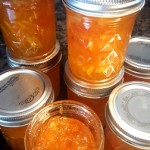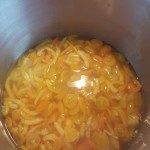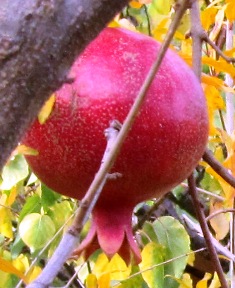How to Make Kumquat Marmalade
Eating a fresh kumquat–the small relative to the sweet orange–is like getting a dose of Vitamin C in a single bite. Or, if you don’t like the tart fruit (the edible rind is sweet), then make your kumquats into a marmalade.
My neighbor recently brought over several boxes of freshly-picked kumquats. We ate some fresh but I turned the rest into a sweet, spread that tastes quite like orange marmalade.
When fruit is available during the year, you can turn that fruit into a delicious conserve, jelly jam, marmalade, or fruit butter. When citrus is in season, oranges, kumquats, grapefruits, and lemons can be coverted to sweet spreads.
There are distinct differences between conserve, jam, jelly, marmalade, and fruit butter. Conserve is a jam made from fruit with other ingredients added, including raisins, coconut, and nuts. Jelly is made from the juice of the fruit while jam is made from the fruit pulp. Marmalade includes fruit, juice, and rind. A fruit butter utilizes the fruit pulp and sugar to make a thick, smooth spread.
KUMQUAT MARMALADE RECIPE
Ingredients:
2 cups thinly sliced kumquats
1.5 cups chopped orange pulp (2 medium oranges)
1.5 cups sliced orange peel (2 medium oranges)
1/3 cup lemon juice
1.5 quarts water
Sugar (the amount will depend on the amount of fruit/water mixture after 12 hours)
Directions:
Mix together all ingredients, except the sugar, in a deep large pot. Simmer for 5 minutes. Remove from heat and cover. In a cool place, allow the mixture to stand for 12 hours or overnight to soften the rind. Remove any large seeds. Cook rapidly until peel has softened. Measure out fruit and liquid mixture and then add 1 cup of sugar for each cup of the fruit mixture. Stir until the sugar is dissolved.
Rapidly bring the mixture to a boil over high heat. Stir as needed to prevent sticking, especially as the mixture thickens and reaches the gelling point. (Hint: You can check to see if the marmalade is gelling by dropping a spoonful of the hot marmalade onto a chilled or frozen saucer. If the marmalade is sheeting instead of running off the plate, it’s ready to can. Also, you can add Classic Pectin according to directions on container to ensure the marmalade properly thickens). Stir in carefully to avoid splattering on your skin. Remove from heat. If the mixture has foam, skim to remove it. And also remove any large seeds that may have been missed.
Ladle the hot fruit mixture into hot jars (run the jars through a hot rinse cycle as the jam is cooking). Leave 1/4-inch headspace. Tighten the ring around the flat, rubber-seal cap. Place the jars into a boiling-water canner. Bring to a boil and process 10 minutes. Remove jars from canner and let stand until cool. The caps will make a popping sound as they cool and seal.
__________________________________________________________________

- All of Meera Lester’s Henny Penny Farmette mysteries are available online and in bookstores everywhere. Also, check out Meera Lester’s self-help books on health, wellness, and spirituality on Amazon.com See: https://www.amazon.com/Meera-Lester/e/B001JP835E
Pomegranate: A Jewel of a Fruit with a Long History
This time of year, you’ll find plenty of pomegranates in the markets and on harvest festival tables. It’s an important fruit in Middle Eastern cuisine. In the fall, pomegranate plants produce garnet-colored fruit with a leathery rind.
The fruit ranges in size from that of a large apple to a small kumquat (for ornamental types of pomegranates). The pomegranate’s treasure, however, is hidden inside. There you’ll find bright red juice and glistening seeds that taste sweet or bittersweet and astringent.
The pomegranate was known to the ancient world. Long before the birth of Christianity, the Egyptians viewed the fruit as a symbol of prosperity. The Bible contains numerous references to the pomegranate and its symbolism as an image of fertility.
The fruit is indigenous to Persia (the area that includes the modern countries of Iran and Iraq). The pomegranate’s popularity has spread since ancient times throughout the Middle East, India, Asia, and elsewhere around the world.
Pomegranate has important uses in the ancient Indian Ayurevedic system of medicine, including as a counterbalance of diets high in sugar and fat. In Northern California’s east bay valleys, the plant is easily cultivated. Our neighbors to the left, right, and rear of our farmette all grow pomegranates.
There are many cultivars of the plant (bushes, trees, and ornamental varieties). Our trees are young and still pretty small. The branches are stiff and tend to arch. Small oval leaves create a delicate open pattern–almost a lacy look–in the garden.
The best method of propagation is through cuttings from wood that is at least a year old. The plants are excellent landscape choices. They are not too picky about soil and as they get older are somewhat drought tolerant. Grow in full sun and irrigate young plants. You[ll be rewarded with trees that remain relatively pest-free and bear plentiful fruit.
Ripe fruit still hanging on the tree can split open, revealing the seeds. But many who grow this fruit and appreciate its nutrient, antioxidant, and medicinal value seldom leave these gems on the tree to over-ripen and fall.
 Facebook
Facebook Goodreads
Goodreads LinkedIn
LinkedIn Meera Lester
Meera Lester Twitter
Twitter








